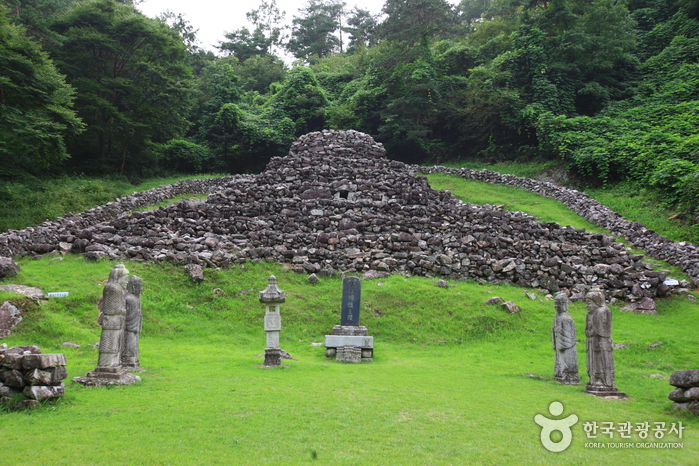Welcome to the Tomb of King Guhyeong!
Step back in time and explore the fascinating history of South Korea at the Tomb of King Guhyeong in Sancheong. This historic stone grave is believed to be the resting place of King Guhyeong, the 10th King of the Gaya Kingdom. Known by various names such as King Guhae or King Yang, he reigned for 11 years before handing over his kingdom to the Silla Kingdom in 532 AD.
A Pagoda or Royal Tomb?
There has been much scholarly debate about the classification of this tomb. Some argue that it should be considered a stone pagoda due to its similarity to other pagodas in nearby regions. However, others believe it to be a royal tomb, as mentioned in ancient history books and local records. These descriptions mention a structure with steps on four faces, resembling nine dragons piled up with stones, located at a distance of about 16 km from the village. These distinctive features have led people to believe it must be a royal tomb.
A Regal Resting Place
The tomb itself is unlike ordinary graves, situated on the middle part of a hill’s slope. It boasts a unique appearance with steps and layers, reaching a height of 7.15 meters at its highest point. While there are seven layers at the front, there are no steps at the back due to the inclined surface. This tomb’s overall shape sets it apart from pyramids built on level ground. At the center, you’ll find a stone tablet with the inscription “Royal Tomb of King Yang of the Garak Nation.” Additionally, several stone pieces have been added to the original tomb, enhancing its grandeur.
Discovering King Guhyeong
The identity of the king buried in this tomb has been recorded in historical writings. The record of travels called “Wangsan Shimreunggi” by Joseon dynasty scholar Hong Ui Young mentions King Guhyeong as the occupant of this tomb. Furthermore, the book “Wangsansagi,” which explores the history of Wangsansa Temple located west of the tomb, confirms that King Guhyeong rests here.
A Glimpse into the Past
In 1793, during the 17th year of King Jeongjo’s reign in the Joseon dynasty, a remarkable discovery was made at the Wangsansa Temple. A wooden box, passed down through generations, was found to contain portraits of King Guhyeong and his queen, their clothing, an archery bow, and other artifacts. To preserve these invaluable items, the royal building known as Deogyangjeon Hall was constructed. Today, this hall serves as a venue for memorial services held in honor of King Guhyeong and his queen every spring and autumn.
How to Get There
If you’re coming from Seoul, make your way to Nambu Terminal and catch an intercity bus to Sancheong Intercity Bus Terminal. Once you arrive, cross the street and head to Sancheong Terminal Bus Stop. From there, take a bus bound for Sancheong-Banggok (Hwagae) and alight at Gu-a Bus Stop.
Embark on a journey through time at the Tomb of King Guhyeong and immerse yourself in the rich history and culture of South Korea. Don’t miss this opportunity to explore one of the country’s most significant historic sites!

